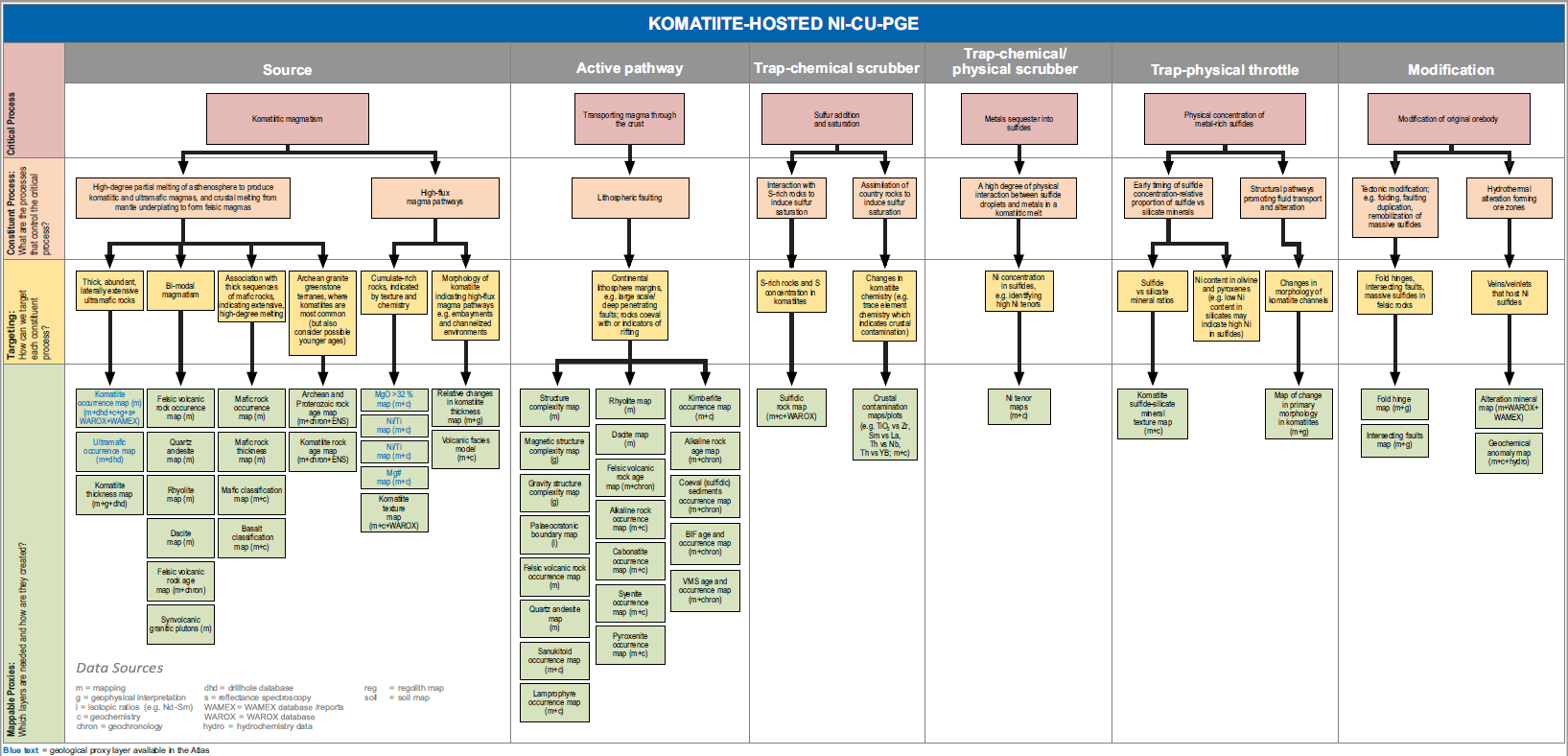Komatiite-hosted nickel sulfide deposits represent some of the world’s largest nickel deposits, and are commonly higher grade than intrusion-related or lateritic nickel deposits (Hoatson et al., 2006). Western Australia hosts several world-class examples of komatiite-hosted nickel sulfide deposits, including Kambalda, Mt Keith and Perseverance (Hoatson et al., 2006).
Targeted ore types
Massive, net-textured and disseminated sulfide ores are commonly present in komatiite-hosted nickel sulfide deposits. Sulfide ores frequently comprise pyrrhotite+pentlandite±pyrite±chalcopyrite.
Mineralization processes
Key processes include the ascent of high-degree partial melts into the crust, typically along long-lived crustal structures. The magmas are dynamic and turbulent, which enables assimilation of crustal material, leading to the introduction of external sulfur to the magma. Nickel, copper, cobalt and PGEs are scavenged from the magma and concentrated in sulfide droplets. These sulfides are concentrated in the crystallizing magmas as massive, net-textured and disseminated sulfide ores (Barnes et al., 2016).
Critical processes
Derived layers are grouped based on their critical features:
SOURCE – of komatiite magma
PATHWAY – location of lithospheric faults and continental lithosphere margins, responsible for transport of komatiitic magma through the crust
CHEMICAL TRAP – addition of sulfur and sulfur saturation of previously sulfur undersaturated magma
CHEMICAL AND PHYSICAL TRAP – sequestering metals into sulfides
PHYSICAL TRAP – concentration of metal-rich sulfides
PRESERVATION – of nickel orebodies
Mineral system analysis
The Mineral System Tree is the graphical display of a mineral system analysis- showing the link between Critical/Constituent processes and their recommended targeting features and GIS layers.
References
Barnes, SJ, Cruden, AR, Arndt, NT and Saumur, BM 2016, The mineral system approach applied to magmatic Ni-Cu-PGE sulphide deposits: Ore Geology Reviews, v. 76, p. 296–316, doi:10.1016/j.oregeorev.2015.06.012.
Hoatson, DM, Subhash, J and Jaques, AL 2006, Nickel sulfide deposits in Australia: Characteristics, resources and potential: Ore Geology Reviews, v. 29, p. 177–241.
Recommended reading
Barnes, SJ, Cruden, AR, Arndt, NT and Saumur, BM 2016, The mineral system approach applied to magmatic Ni-Cu-PGE sulphide deposits: Ore Geology Reviews, v. 76, p. 296–316, doi:10.1016/j.oregeorev.2015.06.012.
Barnes, SJ and Fiorentini, ML 2012, Komatiite magmas and sulfide nickel deposits: A comparison of variably endowed Archean Terranes: Economic Geology, v. 107, p. 755–780.
Barnes, SJ, Hill, RET, Perring, CS and Dowling, SE 2004, Lithogeochemical exploration of komatiite-associated Ni-sulfide deposits: Strategies and limitations: Mineralogy and Petrology, v. 82, p. 259–293.
Hill, RET 2001, Komatiite volcanology, volcanological setting and primary geochemical properties of komatiite-associated nickel deposits: Geochemistry: Exploration, Environment, Analysis, v. 1, p. 365–381.
Hoatson, DM, Subhash, J and Jaques, AL 2006, Nickel sulfide deposits in Australia: Characteristics, resources and potential: Ore Geology Reviews, v. 29, p. 177–241.
Le Vaillant, M, Fiorentini, ML and Barnes, SJ 2016, Review of lithogeochemical exploration tools for komatiite-hosted Ni–Cu–(PGE) deposits: Journal of Geochemical Exploration, v. 168, p. 1–19, doi:10.1016/j.gexplo.2016.05.010.
Lesher, CM and Keays, RR 2002, Komatiite-associated Ni-Cu-(PGE) deposits: Geology, mineralogy, geochemistry and genesis, in The geology, geochemistry, mineralogy and mineral beneficiation of the platinum-group elements edited by LJ Cabri: Canadian Institute of Mining, Metallurgy and Petroleum; Special Volume, p. 579–617.

